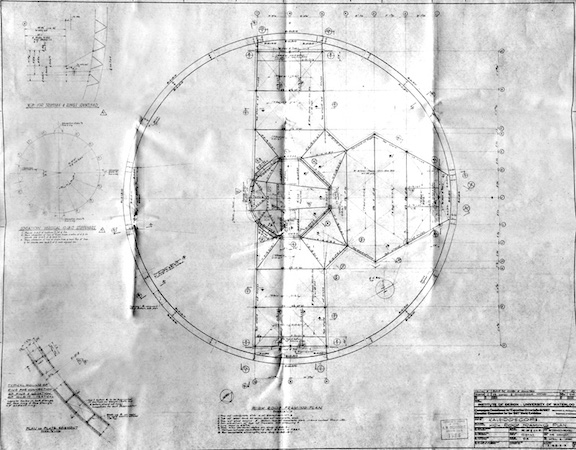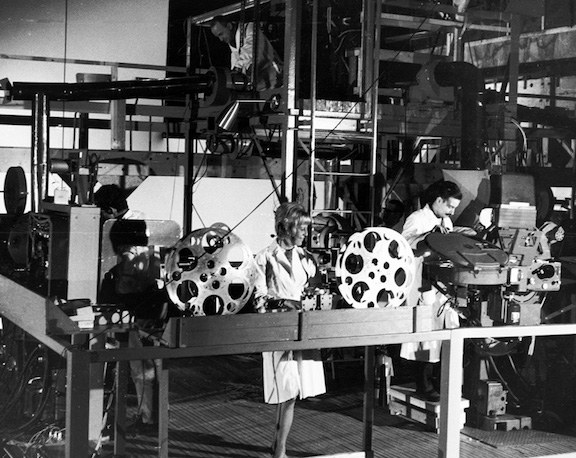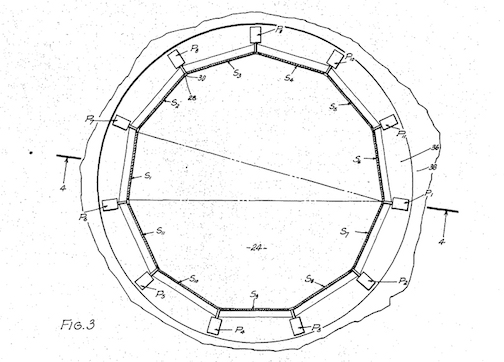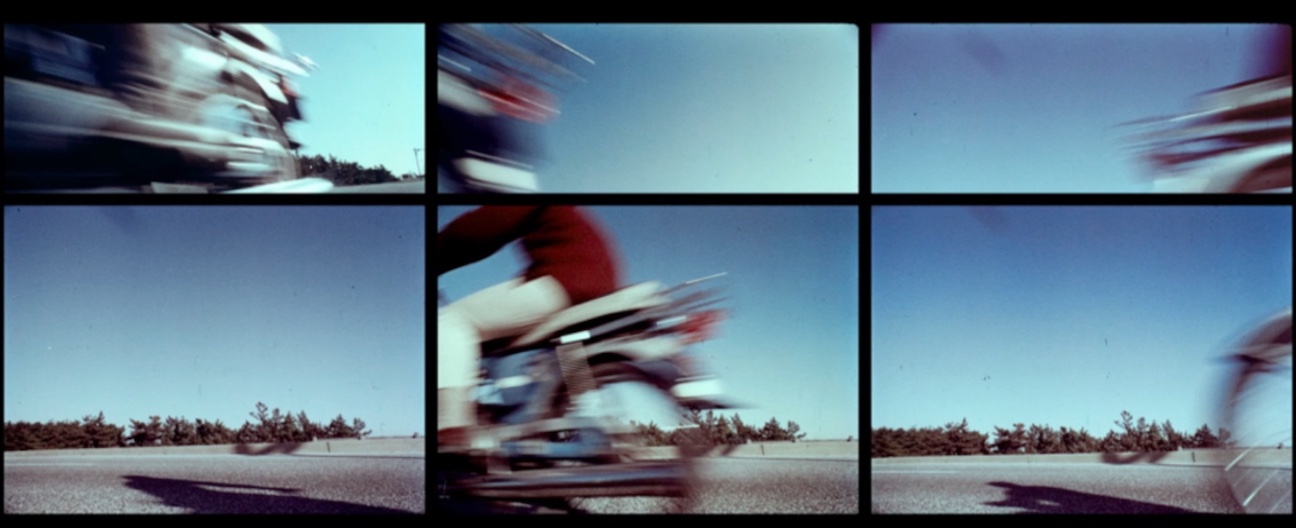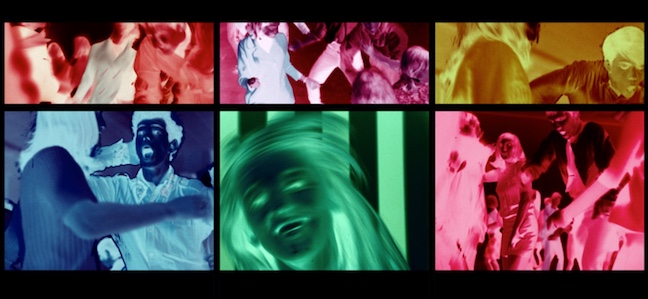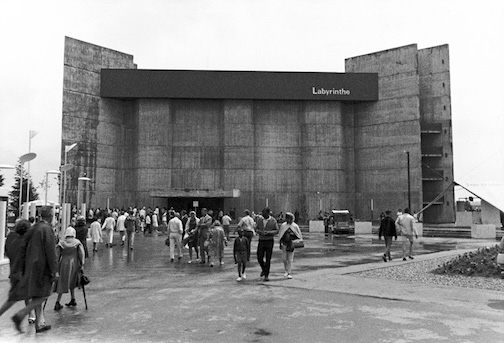Click here to print
Reviewing the Films of Expo 67
posted March 24, 2018
Expo 67, the World’s Fair held in Montreal in 1967, was rather an hallucinogenic affair. Among its most memorable features were its wildly innovative audiovisual projections. They were large, bold, and spectacular.
In purpose-built pavilions, the Expo’s films boasted dazzling arrays of often-huge screens and novel, captivating forms of viewership. Some pavilions, for example, fully immersed viewers within enormous audiovisual arrays.
Long lines formed as word got out that the exposition’s films, like many other aspects of the event, were truly memorable.
Ever since their inception, back in 1851, Expos have been showcases for their host nations’ modernity, however much notions of modernity may come to appear, in retrospect, quaintly of their time. In Canada’s case, the 1967 Expo – the Universal and International Exhibition of 1967 — took place during the centennial year of Canada’s Confederation; the country set out to prove itself worthy of world attention.
Held in Montréal from April to October 1967, the Expo was considered the most successful World’s Fair, to date. It received unprecedented television coverage.
Film was a major draw at Expo 67, but for archivists, and historians, the films pose challenges. So innovative and grand were the cinema Expo’s projects that it is far from certain that archivists will ever be able to restore them, in the traditional sense, says Steve Moore, senior audiovisual archivist at Library and Archives Canada. A full digital restoration, including finding full documentation explaining how the films should be shown, and how various pavilions were designed to show them, would be a very tall order, and require dedicated funds towards an enormous project. “I’d love to do that before I retire,” he says, but in a tone of voice that allows that that is unlikely to happen.
The accomplishment of the Expo
Expo 67 was the first World’s Fair to be called an Expo — from the French exposition (“exhibition”) — as now all are. It dominated public life in Montreal, Quebec, for the six months it ran, starting April 28. Its theme of “Man and His World” was drawn from Antoine de Saint-Exupéry’s book Terre des Hommes. With themes like Man and His World, Man and His Health, Man and the Ocean, and Man and the Environment, the Expo aspired to be socially conscious, even utopian, at a time when the Cold War was threatening to boil over. The event asked: How could humankind use technologies, natural resources, and the capabilities of design and art to overcome its struggles and strife?
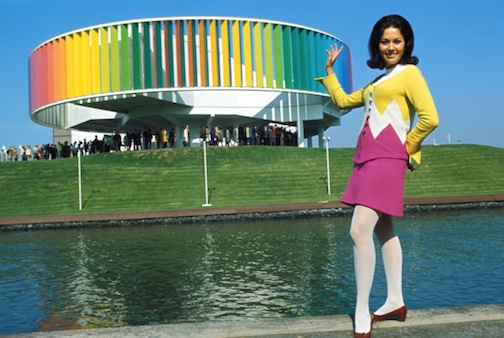
Six Canadian chemical companies sponsored the Kaleidoscope Pavilion, and the University of Waterloo’s Institute of Design and the Toronto design firm of Morley Markson and Associates created it. It housed the 12-minute film “Man and Color.” Viewers moved through a “world of the fantastic” in the form of three theaters in which the three parts of the film were projected onto very large screens with mirrors enhancing the effect of shifting images; those began with shots of an orchard, flowers, and birds, and then of abstract colors, while viewers heard music by Canadian composer R. Murray Schafer. Below: the floor plan of the Kaleidoscope Pavilion, an example of the kinds of materials researchers can use from the Library and Archives Canada collection. Images: Library and Archives Canada.
For such a grandly ambitious event, Expo 67 was hastily planned and constructed (after Moscow backed out, as that year’s host); when readied on time it was hailed as a landmark collaboration of three Canadian governments: Montreal’s, Quebec’s, and the country’s. Planners incorporated startling design elements in buildings, grounds, and details. To increase the utility of the chosen site, in the middle of the St. Lawrence River, they enlarged or improvised three islands using fill from the city’s ongoing underground-railway digs. A monorail led to the Expo site, with its 60 national, industry, and theme pavilions. There visitors found, for example, appealingly designed furniture, signage, and even washrooms and phone booths, not to forget the innovatively constructed Habitat 67, a vision of how to meet emerging human housing needs that now looks decidedly energy-inefficient.
With all those striking elements, Expo 67 projected a splashy sense of “now” that made it a major drawcard. Celebrities from many walks of public life and entertainment visited: Queen Elizabeth, Grace Kelly, Thelonious Monk, Marlene Dietrich, Jacqueline Onassis, the Grateful Dead… Ed Sullivan broadcast live from the site, with the Supremes as musical guests along with Petula Clark, who debuted her smash hit “Don’t Sleep in the Subway.”
As a showcase and celebration of Canada’s capabilities, it was a roaring success.
In selecting and commissioning film projects for the event, organizers sought to expand on the theme of contemporaneity. Screening contexts were developed in collaboration with the architects of the pavilions. That facilitated such spectacles as a 360-degree film-in-the-round projection of Canada 67, a feature about the country that made viewers duck and even swoon when shots taken from helicopter-born cameras made them feel that they were swooping towards natural and man-made objects.
Viewers, even many years later, have recalled films projected on walls and ceilings, split images, and then-stunning footage of, for example, the birth of a baby, in large and in detail.
Among the films’ many striking screening concepts, some are common enough, now, particularly in museums, such as multi-screen auditoriums and surround-screen arrays where audiences watch images all around them. But even today exhibitors would be hard pressed to do what, for example, Roman Kroitor did with his Labyrinthe. Its audience members walked through giant arrays of screens while images came towards them from all sides. That was the germ of the IMAX screening method that Kroitor and other founders readied for the 1970 world’s fair in Osaka, Japan.
Hugely popular, Labyrinthe showed in a specially constructed pavilion. Ushers led viewers in near darkness via a maze of ramps through three chambers. In the first they stood on four, stacked elliptical balconies to view scenes on a 50-feet-high screen that extended above and below them. They then progressed via noisy, flashing passages to other parts of the film, which took its theme from the myth of man defeating the Minotaur. When viewers saw an Ethiopian man in a dugout canoe wielding a spear to battle a crocodile, the images came from multiple screens. You can get some scant sense of what the effect of watching all that might have been, online.
In some venues, audiences could see images and scenes jump from one screen to the next. Or, they1 could move along tracks through a series of screening rooms, or stand in a huge space surrounded by screens, or watch images dancing on 112 moving screen cubes in a vast array before them.
What remains: restoration and recreation
Library and Archives Canada has a large store of material relating to the planning, design, construction, and day-to-day operations of the facilities and events at Expo 67: more than 40,000 architectural drawings plus huge numbers of black-and-white and color photographs, posters, textual and promotional material, and the like.
Through donations from the corporation formed to run the fair, Library and Archives Canada has held most of the Expo 67 records for the last 40 years; since 1997 it has kept them in its main storage and conservation facility, the Preservation Centre, in Gatineau, Quebec.
For the past several years, LAC has been making many items in the collection available to the public via digitization and posting to websites. In the case of the films shown at Expo 67, a significant obstacle is that many of the films no longer exist, or are held in private collections, or were shown in ways that are difficult or impossible to replicate. But LAC does have access to a great deal of information about how and where films were screened, and while metadata is in many cases incomplete, some components of the ambitious cinema projects remain.
But archiving, let alone restoring, the films and film events is no easy task. As Steve Moore says, it would hardly be possible to recreate the buildings and screens initially used, which in most cases no longer exist. Creating them in the first place was no mean feat.
The films came, and went, and some have gone missing. A few did tour cinemas in Toronto and elsewhere, in the years after Expo, and even showed in some multiscreen contexts. Some of the films also went around Canadian schools. That, says Moore, “may explain why many disappeared. At the end of their runs, there was no one to bring them back to a central place. But some may still be discovered.”
Making the films accessible now requires, then, some clever archival approaches, and inevitably some compromises.
The work is falling mainly to two organizations: Library and Archives Canada, and the CINEMAexpo67 research group, in which scholars and artists from Concordia and York Universities have worked to locate, restore, and re-exhibit Expo 67 films, in new forms, in an effort to evoke the extraordinary effect that the films had on the many millions of people who viewed them when they first were shown. Two key members of the group, Monika Kin Gagnon and Janine Marchessault edited a volume of essays, Reimagining Cinema: Film at Expo 67 (McGill-Queen’s University Press, 2014).
“Looking into our files, we realized we had some documentation that explained architecturally how those buildings were set up at Expo to screen the films,” says Moore. But LAC has at best an incomplete knowledge of what holdings it has that relate to the Expo 67 films. With so much other work occupying its very small audiovisual staff, its attention to them has generally been in response to inquiries. It has barely had time to take stock of what it has, in terms of films and supporting material, let alone restore much of it.
Records are partial, and often disordered. “The filmmakers were in a rush, to have films ready in time for Expo,” Moore says. In contexts like that, keeping thorough or reliable documentation has never been a strong feature of film making.
So, for example, LAC does not possess one of the most popular of the Expo 67 films, Canada 67 (it is thought to be lost) so it has adopted an archiving approach that enables it to convey, as much as possible, a sense of what viewing it was like.
The film was Expo 67’s most popular. Running at 22 minutes, it was made in “Circle-Vision,” an exhibition format that saw up to 1,500 people stand in a room surrounded by nine large screens. Walt Disney Studios shot the film with a nine-camera rig. Canada 67 was screened from nine projectors concealed in space between the nine screens. That made the array of images seamless, for viewers. Sound came from 12 synchronized sound channels. Canadian telephone companies commissioned the film to show in The Telephone Pavilion at the Expo.
Viewers have reported being mesmerized by the effects, and the images. With cameras moving via plane, boat, train, and even horseback, they saw Canadian Mounted Police, charging inward with lances pointed towards the viewers; they saw Quebec City’s Winter Carnival, and a Toronto Maple Leafs hockey game; they flew over landscapes of lakes, prairies, farmland, and wilderness, and the country’s most famous rodeo, the Calgary Stampede; they heard a rousing rendition of “O Canada.”
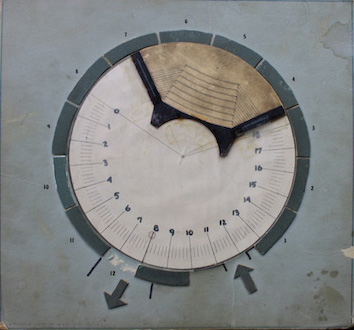
A floor plan for the Man the Explorer theme pavilion , where Graeme Ferguson’s “Polar Life” showed. Library and Archives Canada.
Some audience members recalled, even decades later, that when a camera-bearing plane banked over Niagara Falls, they gasped and tottered.
Other films and their settings were just as idiosyncratic.
For The Earth is Man’s Home, about humans’ adaptation to their environment and its resources, viewers sat in sling chairs in the Man the Explorer Complex to gaze up at a huge 13-by-30-foot screen.
At the United States Pavilion, Art Kane’s 20-minute A Time to Play, whose theme was children’s games, showed on three screens set side by side. Kane used the multiple screens amusingly: for example, during a game of hide-and-seek, the seeker appeared on one screen, a hiding child on another.
In Polar Life at the Man the Explorer theme pavilion, Graeme Ferguson used twelve projectors and four slowly revolving theaters to display images from polar regions.
One film that Library and Archives Canada has restored is We Are Young. Francis Thompson and Alexander Hammid’s contribution, which ran at the C.P.R. Cominco Pavilion sponsored by Canadian Pacific Railway, used six screens and showed hundreds of amateur actors dancing, motorcycling, horse riding, typing in an office, taking part in a peace march… with images split or repeated or segmented across the screens. The filmmakers spent 18 months covering 28,000 miles to capture 19 miles of film to create their 22-minute film.
Like other films at Expo 67, We Are Young ran continuously, on a loop. As a result, reels suffered a great deal of wear and tear. “You had celluloid going through projectors for the course of Expo, so they were quite scratched,” says Moore. And, he adds, in the years since, the film’s original color dye had deteriorated, too – the colors had shifted almost completely to magenta. “They were almost unwatchable.”
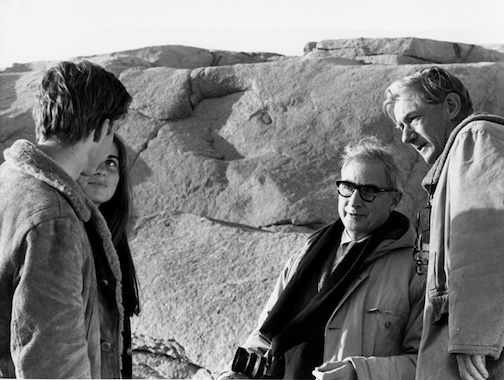
Alexander Hammid (right) and Francis Thompson (second from right) lining up a shot for “We Are Young!” Library and Archives Canada.
When the film originally screened, it was in six parts, projected simultaneously onto six screens, three above, three below. To make its restoration affordable, LAC printed simultaneously projected frames into single frames. A limitation of that approach, clearly, is that the arrangement of images, six at a time, within each 35mm frame, does not replicate the original screening method. But it can provide some sense of the original, shock-of-the-new presentation. Says Moore: “It’s kind of a reconstruction, but you can never get the same experience again because you’re not going to be able to screen it in those buildings.”
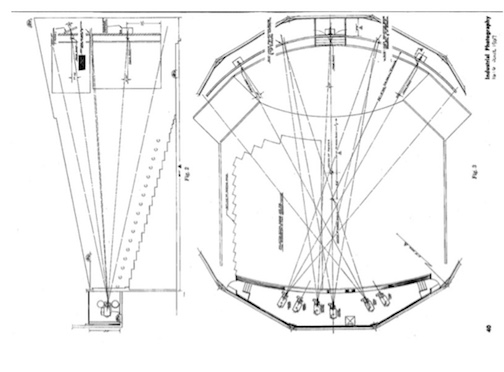
A plan of the Cominco theatre projection on a curved, six-screen array. Library and Archives Canada.
LAC’s job was difficult enough without matching the 1967 set-up, he says. He describes a painstaking reconstruction process to deduce which shots ran at the same time as others, on the five other screens. At times, of course, restorers were able to figure out, logically, what footage ran with what. At other points, their approach was to observe what was on each of the six screens at various times in documentary and news footage that happened to show parts of screenings of the film.
Film at Library and Archives Canada
Taking care of the Expo films is only a small part of the work of Moore and his film-department colleagues at Library and Archives Canada (formed in 2004 from a merger of The National Archives and National Library). LAC holds some 90,000 films — short and full-length films, documentaries and silent films, the oldest dating as far back to 1897. It also has more than 550,000 hours of audio and video recordings.
In Expo material, the LAC collection has, in addition to film-related holdings, some 15,00 color slides and more than 30,000 black-and-white photographs. It has put more than 4,000 images online on its website, with about 70 images highlighted on a Flickr gallery. Many online postings provide views of Expo 67’s accomplishments.
With so much to get on with, LAC doesn’t have a systematic, funded project to sort through all its Expo material to restore the films and properly organize the architectural and technical plans and other documents that supported them, Moore says: “If we find material in a collection, that sometimes happens through a request for information, for example from people who are looking for something, a director who worked on one of the films, say. Then we’ll find material and put it together.” And, he adds: “If we get inquiries and we have something, then we might say, ‘let’s try to preserve it.’”
It stands to reason that the records of such a vast event would hold all kinds of surprises, and one came in 2014 when University of Windsor professor Steven Palmer discovered, in Library and Archives Canada’s collection, one of the most spectacular of the Expo 67 films, until-then considered lost.
At 19 minutes, Robert Cordier’s Miracles of Modern Medicine, projected onto three screens, was plenty long enough to reduce many viewers to a quivering mess. An average of 200 people fainted, each day, from among the 2.5 million who saw the groundbreaking, then remarkably frank medical film.
Its images of human birth, up close, a child undergoing heart surgery, an electrode being inserted into a Parkinson’s disease sufferer’s brain, and a thalidomide-affected child learning to use mechanical arms were not things that people saw, in those days, unless they were medical workers.
Thanks to the discovery, the film has been screened, again.
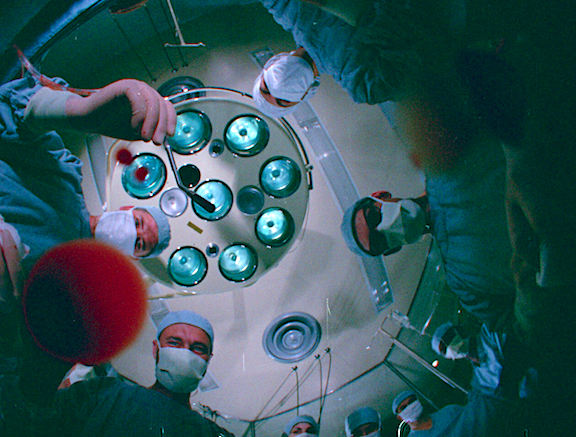
The graphic surgery footage of “Miracles in Modern Medicine” was more than many viewers could manage. Image Library and Archives Canada.
Even after the publication of Gagnon and Marchessault’s Reimagining Cinema: Film at Expo 67, says Moore, “there is still a lot of material there for a researcher to go through and discover more things.”
And in some case, there is not, he knows: For example, one Expo 67 film even innovated with waterfall screens. But “we can’t find any documentation on it,” he says. “It had a constant water flow. There were all kinds of experiments going on.”
The vast Expo 67 records that LAC holds are important to the institution, just as Expo 67 holds an important place in Canada’s history – in the formation of its self-conception, he says. (For Moore, too, the Expo records provoke strong associations. His family migrated to Canada in 1967, by ocean liner, and his first memory of his new country comes from what he saw it from the ship, sailing up the St. Lawrence River: “I remember as a seven year old seeing this huge, round, strange building – that was the U.S. Pavilion.”)
Reviewing Gagnon and Marchessault’s book, Jan Baetens wrote: “Among the most salient features of Expo 67 were its multiple cinematographic shows … some of which have proved key contributions to completely new forms of film-making and film-going.”
Those approaches may now be familiar, but at the time, Baetens wrote, their impact was “truly tremendous.” What’s more, “the pivotal role of Expo 67” in studies of such expansion of cinema’s possibilities and projection “does not always receive the attention it deserves.”
— Peter Monaghan
Printed from Moving Image Archive News: http://www.movingimagearchivenews.org
URL to article: http://www.movingimagearchivenews.org/reviewing-the-films-of-expo-67/
Click here to print
